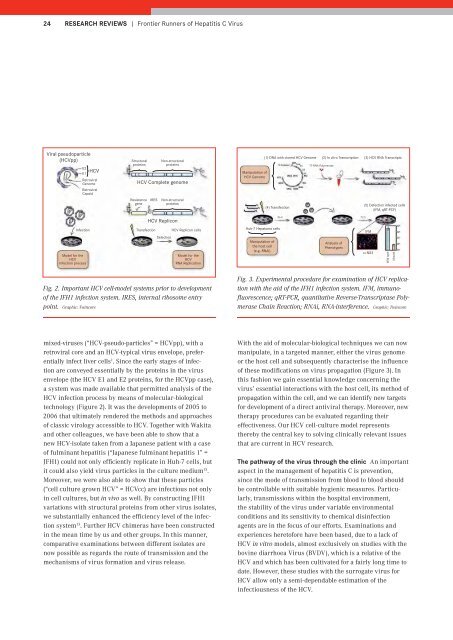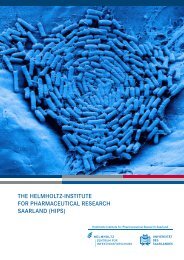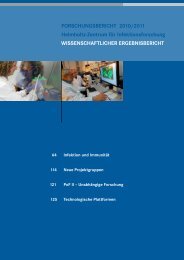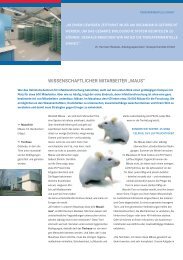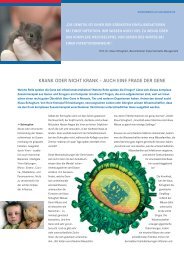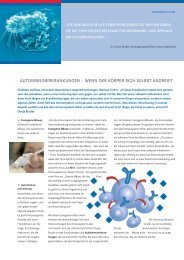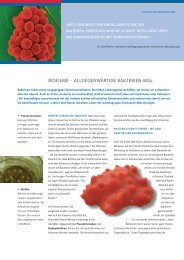Research Report 2010 2011 - Helmholtz-Zentrum für ...
Research Report 2010 2011 - Helmholtz-Zentrum für ...
Research Report 2010 2011 - Helmholtz-Zentrum für ...
You also want an ePaper? Increase the reach of your titles
YUMPU automatically turns print PDFs into web optimized ePapers that Google loves.
24 RESEARCH REVIEWS | Frontier Runners of Hepatitis C Virus<br />
Viral pseudoparticle<br />
(HCVpp)<br />
E2<br />
HCV E1<br />
Retroviral<br />
Genome<br />
Retroviral<br />
Capsid<br />
Structural<br />
proteins<br />
HCV Complete genome<br />
Resistence<br />
gene<br />
IRES<br />
Non-structural<br />
proteins<br />
Non-structural<br />
proteins<br />
Manipulation of<br />
HCV Genome<br />
(1) DNA with cloned HCV Genome (2) In vitro Transcription<br />
(4) Transfection<br />
T7-RNA Polymerase<br />
(3) HCV RNA Transcripts<br />
(5) Defection infected cells<br />
(IFM, qRT-PCF)<br />
HCV Replicon<br />
96 h 72 h<br />
Infection<br />
Model for the<br />
HCV<br />
Infection process<br />
Transfection<br />
Selection<br />
HCV Replicon cells<br />
Model for the<br />
HCV<br />
RNA Replication<br />
Huh-7 Hepatoma cells<br />
Manipulation of<br />
the host cell<br />
(e.g. RNAi)<br />
Analysis of<br />
Phenotypes<br />
IFM<br />
α-NS3<br />
Wild type<br />
Mutant<br />
Fig. 2. Important HCV cell-model systems prior to development<br />
of the JFH1 infection system. IRES, internal ribosome entry<br />
point. Graphic: Twincore<br />
Fig. 3. Experimental procedure for examination of HCV replication<br />
with the aid of the JFH1 infection system. IFM, immunofluorescence;<br />
qRT-PCR, quantitative Reverse-Transcriptase Polymerase<br />
Chain Reaction; RNAi, RNA-interference. Graphic: Twincore<br />
mixed-viruses (“HCV-pseudo-particles” = HCVpp), with a<br />
retroviral core and an HCV-typical virus envelope, preferentially<br />
infect liver cells 1 . Since the early stages of infection<br />
are conveyed essentially by the proteins in the virus<br />
envelope (the HCV E1 and E2 proteins, for the HCVpp case),<br />
a system was made available that permitted analysis of the<br />
HCV infection process by means of molecular-biological<br />
technology (Figure 2). It was the developments of 2005 to<br />
2006 that ultimately rendered the methods and approaches<br />
of classic virology accessible to HCV. Together with Wakita<br />
and other colleagues, we have been able to show that a<br />
new HCV-isolate taken from a Japanese patient with a case<br />
of fulminant hepatitis (“Japanese fulminant hepatitis 1” =<br />
JFH1) could not only efficiently replicate in Huh-7 cells, but<br />
it could also yield virus particles in the culture medium 15 .<br />
More over, we were also able to show that these particles<br />
(“cell culture grown HCV” = HCVcc) are infectious not only<br />
in cell cultures, but in vivo as well. By constructing JFH1<br />
variations with structural proteins from other virus isolates,<br />
we substantially enhanced the efficiency level of the infection<br />
system 13 . Further HCV chimeras have been constructed<br />
in the mean time by us and other groups. In this manner,<br />
comparative examinations between different isolates are<br />
now possible as regards the route of transmission and the<br />
mechanisms of virus formation and virus release.<br />
With the aid of molecular-biological techniques we can now<br />
manipulate, in a targeted manner, either the virus genome<br />
or the host cell and subsequently characterise the influence<br />
of these modifications on virus propagation (Figure 3). In<br />
this fashion we gain essential knowledge concerning the<br />
virus’ essential interactions with the host cell, its method of<br />
propagation within the cell, and we can identify new targets<br />
for development of a direct antiviral therapy. Moreover, new<br />
therapy procedures can be evaluated regarding their<br />
effectiveness. Our HCV cell-culture model represents<br />
thereby the central key to solving clinically relevant issues<br />
that are current in HCV research.<br />
The pathway of the virus through the clinic An important<br />
aspect in the management of hepatitis C is prevention,<br />
since the mode of transmission from blood to blood should<br />
be controllable with suitable hygienic measures. Particularly,<br />
transmissions within the hospital environment,<br />
the stability of the virus under variable environmental<br />
conditions and its sensitivity to chemical disinfection<br />
agents are in the focus of our efforts. Examinations and<br />
experiences heretofore have been based, due to a lack of<br />
HCV in vitro models, almost exclusively on studies with the<br />
bovine diarrhoea Virus (BVDV), which is a relative of the<br />
HCV and which has been cultivated for a fairly long time to<br />
date. However, these studies with the surrogate virus for<br />
HCV allow only a semi-dependable estimation of the<br />
infectiousness of the HCV.


